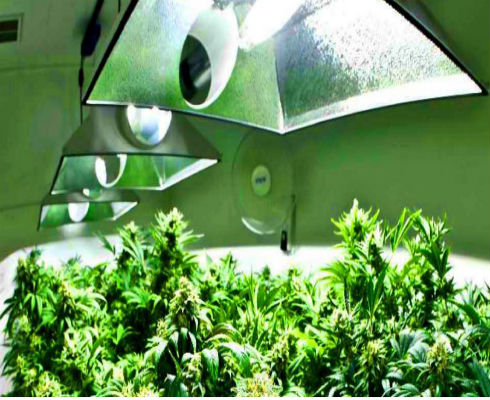Sansi LED: Sustainable LED Lighting and Integrated LED Display
Delivering premium and professional LED Display, LED Lighting, Smart City Integration solutions, trusted by over 60,000 companies worldwide everyday. From industrial lighting to commercial lighting, from outdoor advertising to XR & VR production, Sansi LED greatly improves the quality and sustainability of your business with 30 years of expert experiences.

What happens to plants without light? Previously it was seen as a bad thing by plant growers and was also attempted to be removed from their lights. However, today is a different story. LED grow lights or HPS are well proven to ignite plants to create defense proteins which lead to better colors, tastes, smells and resistance to diseases. Overall making healthier stronger plants. Let us have a further discussion about do LED or HPS can be more efficient for growing plants.

The most commonly used horticultural lighting systems are light-emitting diode (LED) and high pressure sodium lamps (HPS). HPS lights were not originally designed for growing plants. It were designed for light rail and parking garages. However, availability and high output levels have led to be used widely in horticulture. HPS provide very high light intensities, most of which emit light in the 565-700 nm range. It is an effective way to accelerate photosynthesis.
Many growers could argue about whether HPS lights are better or worse than LEDs. The fact is, it relies on your needs and priorities for your plants. Because full spectrum LED grow lights can speed up the plant's growth cycle. In contrast, if the plant's lighting requirements can be matched with the plant accordingly the effect will be significant. The plant's growth cycle could be shorter, also the plant yield and quality will be improved. This is the reason for the emergence of plant lights. The efficiency and effectiveness of LED grow lights are the reasons why they are now replacing traditional plant growth lights.
Customized spectrum advantage
Visible light is made up of various colors on the light spectrum that vary across a wavelength range between 380 nm to 750 nm. For photosynthesis plants use a wavelength between 400 & 700 nanometers. Thus making visible light produced by the sun ideal for plants in order to help them photosynthesize.
The absorbed light energy accounts for about 60%-65% of the physiological radiation energy. Among them, red orange light with a wavelength of 610-720 nm and blue and violet light with a wavelength of 400-510 nm. LED can emit the monochromatic light spectrum required for plant growth. The effective utilization rate of light energy can reach 80%-90%, achieve separate control of different light quality and luminous intensity. While each HPS light has only one light source (360°bulb), it is necessary to rely on the reflector to spread the light evenly over the canopy of the crop. A customized spectrum is a better choice for growers.

High space utilization
Plants have been found to not bloom until there is a suitable amount of infrared light available. Infrared light is on the edge of the visible light spectrum at 700 nanometers. It provides heat and has been found to play a part in the blooming of flowers. Especially indoor growers use fluorescent lights without infrared.
For plant growers, the space utilization rate is also a key factor determining its production capacity. LED can achieve high-density planting environment. Small size, low heat dissipation, and the minimum spacing in plant can reach 300mm. The LED can effectively control the mid-infrared and far-out spectral distribution of the spectrum, so that the plants can be irradiated at close range without burning plants.
HPS lights also produce a lot of heat energy, which often needs extra air flow tools to keep an appropriate grow environment. If not managed as well, the heat energy can easily make plants burn. This is especially troubling if your plants are already limited to temperature complications. As far as infrared light is concerned with plants growth, it provides many benefits.


Energy efficiency
The energy saving effect in power consumption of LED is remarkable. It accounts for 1/2 of the energy-saving lamps, 5/1 of the HPS lights. Compared to HPS lights, LED grow light has longer life (L≥50,000 hours), stable performance and low maintenance costs. Actually, LED-based horticultural lighting systems are achieving more than 45% greater photon efficiency than HPS lights.However, the cost of LED horticultural lighting systems is relatively high. LED, as a horticultural lighting system and it can be placed near plants while protecting plants from heat radiation.
HPS grow lights diminish in intensity dramatically and must be replaced every 12-18 months. As a result, it can lead to more operation costs. When producing the same light output, HPS lights could consume more energy than LEDS. HPS lights for horticultural lighting is the generation of large amounts of radiant heat. The surface temperature of the HPS lights can reach temperatures above 800 °F (about 430 °C), so there must be sufficient distance between the plant canopy and the HPS lights. As a result, it will reduce the illumination rate. Energy efficiency should be taken into consideration when growing plants.
SANSI customized solutions to growers
SANSI C2020-BE high power dimmable LED grow light is specifically designed for large-scale indoor gardening in environments with little or no daylight. Adopting SANSI patented ceramic LED technology, it features energy efficiency, low power consumption, uniformed light distribution, adjustable spectrum. C2020-BE offers significant grow lighting solutions for vertical farming, commercial greenhouse, indoor farming, etc.

Each LED chip is mounted in a circle providing uniformed light and spectrum distribution. High luminous efficiency, 90% of the light can be absorbed by plants and flowers, life expectancy up to 50,000 hours. All materials meet the requirements of environmental protection. Moreover, intelligent control on lighting spectrum, individually adjustable red, white, blue dimmers allow precise 3-channel spectral control, meeting various plant growth applications. SANSI deserves the best choice for your grow plants.
